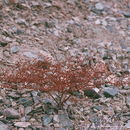Comments
(
Inglês
)
fornecido por eFloras
Eriogonum brachypodum is variable in overall shape, peduncle length, and shape and size of involucres and flowers. Spreading plants with longish peduncles and narrow involucres occur in southwestern Utah and adjacent portions of Nevada and Arizona; this is the “
parryi” phase of the species. Typical
E. brachypodum is low and flat-topped, with the inflorescence up to 10 dm across. The involucres are usually sessile and campanulate rather than turbinate. The two phases intergrade completely and a taxonomic distinction is not warranted. Dried plants of the typical phase often are used as decorations.
The species is common and even weedy in places. It occurs from Churchill and Pershing counties, Nevada, south through Mono and Inyo counties to eastern Kern and San Bernardino counties, California, then eastward through Nevada (Clark, Esmeralda, Lincoln, Mineral, and Nye counties) into southwestern Utah (Beaver and Washington counties) and northwestern Arizona (Mohave County). It is much more common in the Mojave Desert than in the Great Basin.
- licença
- cc-by-nc-sa-3.0
- direitos autorais
- Missouri Botanical Garden, 4344 Shaw Boulevard, St. Louis, MO, 63110 USA
Description
(
Inglês
)
fornecido por eFloras
Herbs, spreading, annual, 0.5-4 dm, glandular, greenish. Stems: caudex absent; aerial flowering stems erect, solid, not fistulose, 0.2-0.7 dm, glandular. Leaves basal; petiole 1-4 cm, tomentose; blade orbiculate to cordate, 1-3(-5) × (1.5-)2-5 (5.5) cm, densely white-tomentose abaxially, less so to subglabrous and green adaxially, margins usually smooth. Inflorescences cymose, open to rather diffuse, often flat-topped, 3-40 × 3-100 cm; branches glandular; bracts scalelike, 1-3 × 0.5-1.5 mm. Peduncles absent or deflexed, straight, stoutish, 0.1-1.5 cm, glandular. Involucres turbinate to campanulate, 1-2.5 × 1.5-2.5 mm, glandular; teeth 5, erect, 0.3-1 mm. Flowers 1-2.5 mm; perianth white with greenish or reddish midribs, becoming reddish, glabrous; tepals dimorphic, those of outer whorl ovate to oblong and often auriculate proximally, those of inner whorl usually lanceolate; stamens included to exserted, 1.5-2.5 mm; filaments glabrous or pilose proximally. Achenes brown to black, lenticular to 3-gonous, 1.5-2 mm, glabrous. 2n = 40.
- licença
- cc-by-nc-sa-3.0
- direitos autorais
- Missouri Botanical Garden, 4344 Shaw Boulevard, St. Louis, MO, 63110 USA
Distribution
(
Inglês
)
fornecido por eFloras
Ariz., Calif., Nev., Utah.
- licença
- cc-by-nc-sa-3.0
- direitos autorais
- Missouri Botanical Garden, 4344 Shaw Boulevard, St. Louis, MO, 63110 USA
Habitat
(
Inglês
)
fornecido por eFloras
Sandy to gravelly washes, flats, and slopes, saltbush, creosote bush, greasewood, mesquite, blackbrush, and sagebrush communities, pinyon-juniper woodlands; 100-2300m.
- licença
- cc-by-nc-sa-3.0
- direitos autorais
- Missouri Botanical Garden, 4344 Shaw Boulevard, St. Louis, MO, 63110 USA
Synonym
(
Inglês
)
fornecido por eFloras
Eriogonum deflexum Torrey subsp. brachypodum (Torrey & A. Gray) S. Stokes; E. deflexum var. brachypodum (Torrey & A. Gray) Munz; E. deflexum subsp. parryi (A. Gray) S. Stokes; E. parryi A. Gray
- licença
- cc-by-nc-sa-3.0
- direitos autorais
- Missouri Botanical Garden, 4344 Shaw Boulevard, St. Louis, MO, 63110 USA
Eriogonum brachypodum
(
Inglês
)
fornecido por wikipedia EN
Eriogonum brachypodum is a species of wild buckwheat known by the common name Parry's buckwheat. This annual herb is native to the southwestern United States from California to Utah and especially the Mojave Desert. It grows in sandy and gravelly substrates. It has a skeletonlike spindly stem which branches many times. It can grow 5 to 50 centimeters in height and up to a meter in width. There is an array of rounded, dark-colored leaves around the base. Leaves are a few centimeters long and fuzzy on the undersides. Most of the plant is actually the spreading inflorescence. At intervals on the otherwise naked branches hang tiny clusters of glandular flowers a few millimeters wide in involucres of bell-shaped bracts. Each flower is less than three millimeters wide.[1]
References

- licença
- cc-by-sa-3.0
- direitos autorais
- Wikipedia authors and editors
Eriogonum brachypodum: Brief Summary
(
Inglês
)
fornecido por wikipedia EN
Eriogonum brachypodum is a species of wild buckwheat known by the common name Parry's buckwheat. This annual herb is native to the southwestern United States from California to Utah and especially the Mojave Desert. It grows in sandy and gravelly substrates. It has a skeletonlike spindly stem which branches many times. It can grow 5 to 50 centimeters in height and up to a meter in width. There is an array of rounded, dark-colored leaves around the base. Leaves are a few centimeters long and fuzzy on the undersides. Most of the plant is actually the spreading inflorescence. At intervals on the otherwise naked branches hang tiny clusters of glandular flowers a few millimeters wide in involucres of bell-shaped bracts. Each flower is less than three millimeters wide.
- licença
- cc-by-sa-3.0
- direitos autorais
- Wikipedia authors and editors
Eriogonum brachypodum
(
Vietnamita
)
fornecido por wikipedia VI
Eriogonum brachypodum là một loài thực vật có hoa trong họ Rau răm. Loài này được Torr. & A.Gray mô tả khoa học đầu tiên năm 1870.[1]
Chú thích
Liên kết ngoài
- licença
- cc-by-sa-3.0
- direitos autorais
- Wikipedia tác giả và biên tập viên
Eriogonum brachypodum: Brief Summary
(
Vietnamita
)
fornecido por wikipedia VI
Eriogonum brachypodum là một loài thực vật có hoa trong họ Rau răm. Loài này được Torr. & A.Gray mô tả khoa học đầu tiên năm 1870.
- licença
- cc-by-sa-3.0
- direitos autorais
- Wikipedia tác giả và biên tập viên

